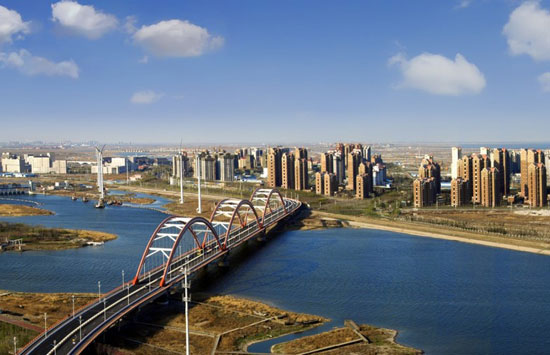November 29, 2014 – Cities are where human ingenuity is demonstrating how to address climate change and implement smart green solutions. The C40 Climate Leadership Group, which started in 2005, includes 69 megacities representing one in 12 on this planet. These cities are setting collective goals focused on better urban planning, development of mass transit while reducing car dependency, making downtowns livable places, hardening infrastructure to withstand extreme weather events, and addressing global warming and climate change.
The megacities aren’t alone in attempting to alter their urban settings. In fact, much of what the C40 Climate Leadership Group accomplishes is shared globally on their website and through other means of outreach.
In China a new city designed for 350,000 residents, small by Chinese standards, is slowly emerging in an area about half the size of Manhattan. Called Tianjin Eco-City, it is a joint venture between China and Singapore. Its vision is to be “a thriving city which is socially harmonious, environmentally-friendly and resource efficient – a model for sustainable development.”
The city goal is to address three harmonies and three abilities. The harmonies address the social, economic and environment. The abilities address affordability, replicability and scalability. Located about 150 kilometers (approximately 90 miles) from Beijing, Tianjin covers 30 square kilometers (11.58 square miles).
China has established key performance indicators for this smart city project. These include establishing an air quality standard that meets or exceeds national ambient grades for sulfur dioxide and nitrous oxide for 310 days of the year. Carbon emissions per U.S. million dollar units of gross domestic product cannot exceed 150 tons. Natural wetlands must be sustained. Water quality must meet the highest national standards and anything coming out of the tap in households must be drinkable. Buildings must meet green building standards. The urban vegetation must be 70% native species. Green space must be at least 12 square meters (approximately 130 square feet) per inhabitant.
Other standards to be met include:
- 20% of all energy used should come from renewable solar and geothermal.
- 50% of the water used should come from desalination and recycled grey water.
- 20% of the housing should be publicly subsidized.
- 100% of the city should be disability accessible.
- 60% of waste should be recycled.
- 90% of trips should be green (public transit, cycling and walking).
A visit to Tianjin Eco-City upon close inspection reveals unique characteristics. All roadside trash cans have solar panels covers and LEDs that light up at night. The buses are electric and transit is free. Drainage wells to handle storm water are embedded into curbs. Pavement is sand brick to produce efficient drainage. Rainwater and wastewater are separated with submerged pumps feeding the former to surrounding and urban wetlands.
The only problem it seems in Tianjin Eco-City is the lack of population. Right now 20,000 people reside in an urban space designed for almost 18 times that number. The Chinese government wants the city to become a model for all of its urban spaces. That’s because China is undergoing a rapid transition from rural to urban with one billion expected to live in the latter by 2030. And with most of its current cities enveloped in smog and with groundwater in 198 of its cities testing as bad or extremely bad, the government needs to make the experiment work and replicate it throughout the country.
Considering what was on the site before Tianjin Eco-City began to rise, China may succeed. From an area back in 2007, contaminated by mercury, DDT, and wastewater, and from land too saline for anything to grow, an eco-city has emerged.













